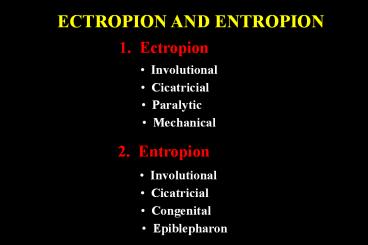ECTROPION AND ENTROPION - PowerPoint PPT Presentation
1 / 17
Title:
ECTROPION AND ENTROPION
Description:
ECTROPION AND ENTROPION 1. Ectropion Involutional Cicatricial Paralytic Mechanical 2. Entropion Involutional Cicatricial Congenital Epiblepharon Involutional Affects ... – PowerPoint PPT presentation
Number of Views:2762
Avg rating:3.0/5.0
Title: ECTROPION AND ENTROPION
1
ECTROPION AND ENTROPION
1. Ectropion
- Involutional
- Cicatricial
- Paralytic
- Mechanical
2. Entropion
- Involutional
- Cicatricial
- Congenital
- Epiblepharon
2
Involutional
- Affects lower lid of elderly patients
- May cause chronic conjunctival inflammation
- and thickening
3
Preoperative assessment
Postition of maximal ectropion
Horizontal lid laxity
Medial canthal tendon laxity
Lateral canthal tendon laxity
4
Treatment of medial ectropion
Mild
Medial conjunctivoplasty
a
b
Lazy-T procedure
Severe
5
Treatment of extensive ectropion
a
b
Without marked excess skin
Horizontal lid shortening
a
b
With marked excess skin
Kuhnt-Szymanowski procedure
6
Causes of cicatricial ectropion
- Contracture of skin pulling lid away from globe
- Unilateral or bilateral, depending on cause
Unilateral ectropion due to traumatic scarring
Bilateral ectropion due to severe dermatitis
7
Treatment of cicatricial ectropion
Method depends on severity
Mild localized cases are treated by excision of
scar tissue combined with Z-plasty
Severe cases require transposition flaps or free
skin grafts
8
Paralytic ectropion
Caused by facial nerve palsy which, if severe,
may give rise to the following
Epiphora caused by combination of
Exposure keratopathy caused by lagophthalmos
- Failure of lacrimal pump
- mechanism
- Increase in tear production
- resulting from corneal exposure
9
Treatment Options for Paralytic Ectropion
1. Temporary treatment
- Lubrication with tear substitutes in mild cases
- Botulinum toxin injection into levator muscle
for corneal - exposure
- Temporary tarsorrhaphy in patients with poor
- Bells phenomenon
2. Permanent treatment
- Medial canthoplasty if medial canthal tendon is
intact
- Medial wedge resection to correct medial
ectropion - associated with medial canthal laxity
- Lateral canthal sling to correct residual
ectropion - and raise lateral canthus
10
Mechanical ectropion
Mechanical lid eversion by tumour
Treatment
- Removal of the cause, if possible
- Correction of significant horizontal lid laxity
11
Involutional entropion
Affects lower lid because upper lid has wider
tarsus and is more stable
If longstanding may result in corneal ulceration
12
Pathogenesis of involutional entropion
- Horizontal lid laxity
- Overriding of preseptal over
- pretarsal orbicularis during lid
- closure
- Canthal tendon laxity
- Weakness of lower lid retractors
13
Treatment options for involutional entropion
- Weis procedure
- (permanent)
- Jones procedure
- Transverse everting
- sutures (temporary)
(for recurrences)
14
Cicatricial entropion
- Severe scarring of palpebral conjunctiva
- which pulls lid margin towards globe
- May affect lower or upper eyelid
- Causes include cicatrizing conjunctivitis,
- trachoma and chemical burns
15
Treatment options for cicatricial entropion
- Corneal protection from lashes by epilation or
contact lenses
- Mucous membrane grafts to replace contracted
conjunctival - tissue for severe cases
Tarsal fracture procedure for mild cases
16
Congenital entropion
- Very rare - not to be confused with epiblepharon
- Inturning of entire lower eyelid and lashes
- Absence of lower lid crease
- When skin is pulled down lid also pulls away
from globe
- Does not resolve spontaneously
17
Epiblepharon
- Very common, especially
- in Orientals
- Extra horizontal row of
- skin across lid margin
- Lashes point vertically,
- especially medially
- Presence of lower lid crease
- When fold of skin is pulled
- down lashes turn out but lid
- remains in apposition to globe
- Frequently resolves
- spontaneously































